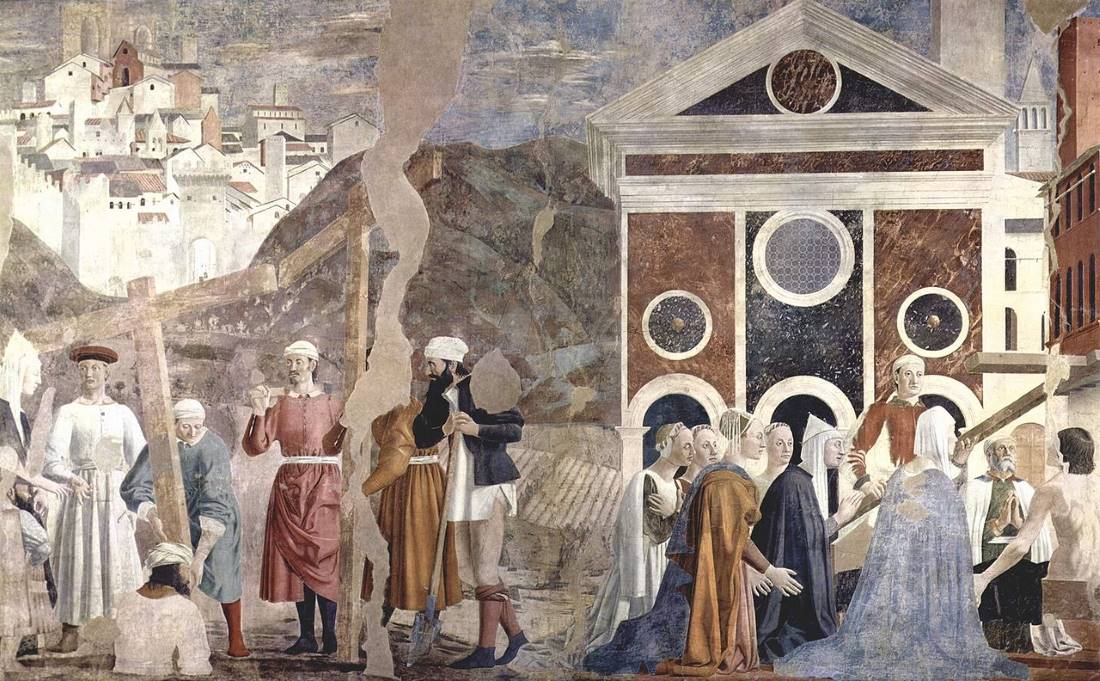Helena was the mother of Constantine the Great, the first Roman emperor to convert to Christianity. Born of humble beginnings, her extraordinary destiny led her to a position of influence and power within the burgeoning Christian community. Beyond being an empress mother, Helena is remembered for her devout pilgrimages to the Holy Land, where she significantly contributed to Christian causes.
One of her most notable accomplishments was the discovery of the True Cross, believed to be the actual cross upon which Jesus was crucified. This event not only solidified her status as a figure of paramount importance to early Christianity but also had far-reaching consequences for the spread of the faith.
In Search of the True Cross
The triumph of Constantine marked the dawn of a substantial reform within the church, which until then had operated under obscure conditions. This victory initiated a series of transformations, one of which was the strengthening of the cult of relics within Christian practice. In this newfound era of religious fervor and legitimacy, the reverence for holy artifacts burgeoned, setting the stage for one of the most consequential quests in Christian history – the search for the True Cross.

By the mid-4th century, according to multiple sources describing various periods from Jerusalem’s patriarch Cyril to the last pagan emperor Julian the Apostate, remnants of the Holy Cross were believed to be located within the Church of the Holy Sepulchre. These accounts spurred Helena’s journey to the Holy Land. Motivated by devout faith and the escalated importance of relics, her pilgrimage had an ambition at its heart: to recover the cross upon which Jesus Christ was traditionally believed to have been crucified. This sacred expedition was not merely a personal undertaking of faith, but a monumental endeavor echoing the newfound strength and spirit of the early Christian Church.
Gelasius of Caesarea: Helena’s Revelation
The tradition of Helena’s pivotal role in the discovery of the Cross was first recorded by Gelasius of Caesarea (367—395?), the bishop renowned for his now-lost Ecclesiastical History. However, the essence of Gelasius’s work was preserved through a partial Latin translation and adaptation by Rufinus of Aquileia in the early 5th century. This adaptation provided posterity with the original legend of Helena and the finding of the True Cross.
According to Gelasius, soon after the Council of Nicaea in 325, Helena was guided by a divinely inspired vision to journey to Jerusalem in search of the Cross. Yet, in the ancient city, the exact location of Golgotha had been long forgotten, obscured under a pagan temple. A subsequent revelation directed Helena to this hidden site, prompting her to command the temple’s demolition, under which three crosses were uncovered.
Identifying the True Cross amongst the three was a quandary, as Christ was crucified alongside two thieves, making immediate recognition impossible. However, a decisive test was conducted by Macarius of Jerusalem, who brought the crosses to a gravely ill woman. After two unsuccessful attempts, the third cross demonstrated its miraculous nature by curing her. This profound event identified it as the True Cross.
Helena placed the Cross in a new church erected at the site of discovery, while fragments and the nails from the crucifixion were sent as holy relics to her son, Constantine, in Constantinople. The final segment of the narrative depicts a feast Helena hosted for the nuns, personally serving them and thus presenting herself as a servant of Christ’s handmaidens.
This version of the legend was later corroborated by early 5th-century Church historians like Socrates Scholasticus, Sozomen, and Theodoret of Cyrus. Furthermore, the tale of Helena’s quest reached the Latin fathers such as Ambrose of Milan, Paulinus of Nola, and the hagiographer Sulpicius Severus, through pilgrims coming from the Western part of the Roman Empire.
The Legend of Judas Cyriacus
Originally, the story of the discovery of the True Cross was documented in Greek and later in Latin. However, a different version emerged in the East after the year 400, commonly referred to in historical scholarship as the “Legend of Jude Cyriacus.” This narrative, initially recorded in Syriac, offers an alternate account of Helena’s quest in Jerusalem.
In this version, Helena, while searching for the Cross, arrived in Jerusalem and demanded, under threat of force, that the local Jewish population reveal Golgotha’s location. Helena’s discourse resembled contemporary Christian polemical writings against Judaism, condemning Jewish disbelief in Christ as the Savior. A young Jewish man, Jude Cyriacus, aware of an ancient prophecy stating that the discovery of the Cross would herald Judaism’s downfall, initially refused to disclose the location where the True Cross was hidden.
Only after enduring torture did Jude agree to join the quest. Guided by divine providence, he uncovered the site containing the Cross, subsequently embracing the Christian God and abandoning Judaism through baptism. The authenticity of the True Cross was affirmed when it miraculously resurrected a dead youth through its divine power. In honor of this holy site, Helena commissioned the construction of a church at Golgotha and appointed Jude as the bishop of Jerusalem.
Jude later met a martyr’s death on the orders of the pagan emperor Julian the Apostate. The Legend of Jude Cyriacus’s anti-Jewish undertones influenced its popularity throughout the Middle Ages, making it the most widespread version of the legend of Helena and the True Cross, both in the Greek East and the Latin West.
Historical Challenge: Can You Conquer the Past?
Answer more than 18 questions correctly, and you will win a copy of History Chronicles Magazine Vol 1! Take our interactive history quiz now and put your knowledge to the test!

